Decentralized Finance (DeFi) is a financial system that is built on blockchain technology. It is designed to be open, transparent, and accessible to everyone. DeFi 1.0 is the first generation of DeFi protocols, and it has been focused on providing basic financial services such as lending, borrowing, and trading. DeFi 2.0 is the next generation of DeFi protocols, and it is focused on improving on the limitations of DeFi 1.0 and providing more advanced financial services.
DeFi Developments
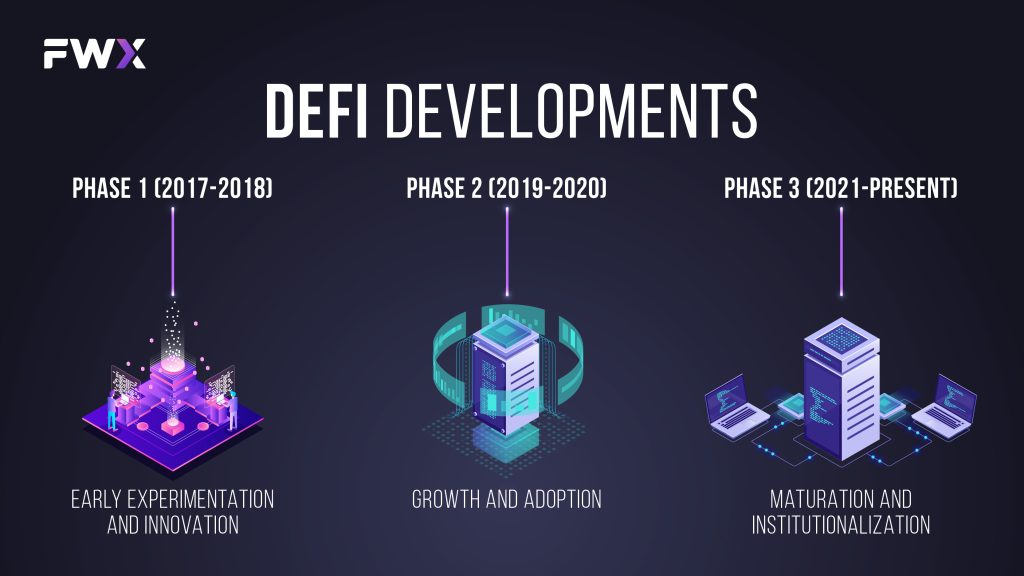
DeFi has been growing rapidly in recent years, and there are now a wide range of DeFi applications available, including decentralized exchanges, lending protocols, and asset management platforms. DeFi is still in its early stages of development, but it has the potential to revolutionize the way financial services are delivered.
Here is a brief overview of the development of DeFi from the beginning until now:
Phase 1 (2017-2018): Early experimentation and innovation
The first phase of DeFi was characterized by early experimentation and innovation. This was the time when the first decentralized exchanges (DEXes) and lending protocols were developed. Some of the notable projects from this phase include Uniswap, MakerDAO, and Compound.
Phase 2 (2019-2020): Growth and adoption
The second phase of DeFi was marked by significant growth and adoption. This was the time when DeFi protocols started to gain mainstream attention and attract a large number of users. Some of the notable projects from this phase include Aave, Yearn.finance, and Synthetix.
Phase 3 (2021-present): Maturation and institutionalization
The third and current phase of DeFi is characterized by maturation and institutionalization. This is the time when DeFi protocols are becoming more sophisticated and secure, and they are also starting to attract institutional investment. Some of the notable projects from this phase include DyDx, dYdX, and Perpetual Protocol.
These projects are building on the foundations of the previous two phases to create a more robust and scalable DeFi ecosystem. For example, DyDx is a decentralized derivatives exchange that offers high-performance trading on a variety of crypto assets. dYdX is a decentralized margin trading platform that allows users to trade with leverage. Perpetual Protocol is a decentralized perpetual contract exchange that allows users to trade on the future price of crypto assets.
What is DeFi 1.0?
DeFi 1.0 is the first generation of decentralized finance (DeFi) protocols. It is built on blockchain technology and allows users to access financial services without the need for a central intermediary. DeFi 1.0 protocols offer a variety of services, including lending, borrowing, trading, and asset management.
DeFi 1.0 protocols are typically built on the Ethereum blockchain. They use smart contracts to automate financial transactions, and they allow users to interact with them directly without the need for a central authority. DeFi 1.0 protocols have been very successful in providing basic financial services to the crypto community, but they still have some limitations.
Pros and Cons of DeFi 1.0
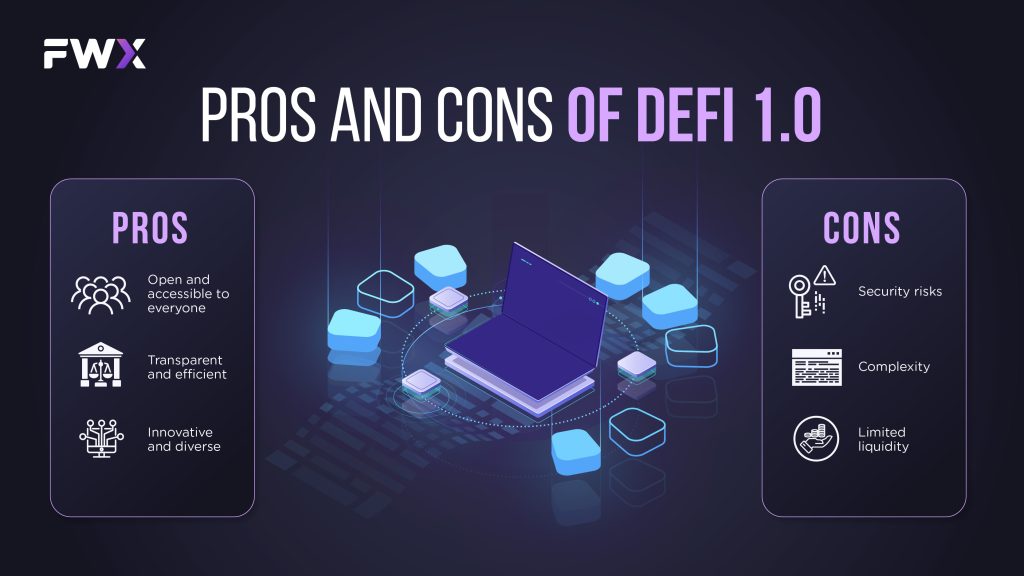
Benefits of DeFi 1.0:
- Open and accessible to everyone: DeFi 1.0 protocols are open to everyone, regardless of their location or financial status. This is a major benefit over traditional financial systems, which often exclude people from developing countries or with poor credit history.
- Transparent and efficient: DeFi 1.0 protocols are transparent and efficient, as all transactions are recorded on the blockchain. This makes it easy to track and audit all activity on the protocol, and it also helps to reduce the risk of fraud.
- Innovative and diverse: DeFi 1.0 protocols are innovative and diverse, offering a wide range of financial services that are not available in the traditional financial system. For example, DeFi 1.0 protocols allow users to lend and borrow crypto assets, trade synthetic assets, and earn interest on their crypto holdings.
Risks of DeFi 1.0:
- Security risks: DeFi 1.0 protocols are still under development, and they are vulnerable to security risks such as hacks and exploits. This is a major concern for users, as it could lead to the loss of their funds.
- Complexity: DeFi 1.0 protocols can be complex and difficult to use, especially for beginners. This is because DeFi users need to have a basic understanding of blockchain technology and smart contracts in order to interact with DeFi protocols safely.
- Limited liquidity: Some DeFi 1.0 protocols have limited liquidity, which can make it difficult to trade assets or get loans. This is because DeFi protocols are still relatively new, and they have not yet attracted a large number of users.
What is DeFi 2.0?
DeFi 2.0 is the next generation of decentralized finance (DeFi) protocols. It is designed to address the limitations of DeFi 1.0 protocols, such as security risks, complexity, and limited liquidity. DeFi 2.0 protocols aim to make DeFi more accessible, secure, and efficient for everyone.
Pros and Cons of DeFi 2.0
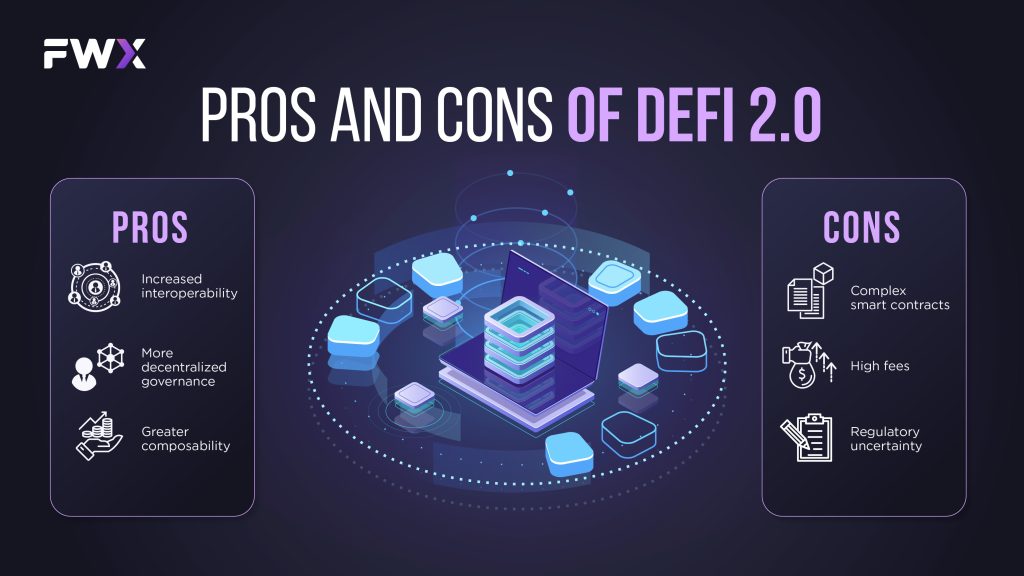
Benefits of DeFi 2.0:
- Increased interoperability: DeFi 2.0 protocols are being designed to be more interoperable with each other and with other blockchains. This will make it easier for users to move their assets between different DeFi protocols and blockchains.
- More decentralized governance: DeFi 2.0 protocols are increasingly being governed by decentralized autonomous organizations (DAOs). This gives users more control over the development and management of the protocols.
- Greater composability: DeFi 2.0 protocols are designed to be more composable, meaning that they can be easily integrated with each other to create new and innovative financial products and services.
Risks of DeFi 2.0:
- Complex smart contracts: DeFi 2.0 protocols often use complex smart contracts. This can make them difficult to audit and understand, and it can also increase the risk of bugs and security vulnerabilities.
- High fees: Some DeFi 2.0 protocols can have high fees. This is because they are often new and have not yet attracted enough liquidity.
- Regulatory uncertainty: The regulatory landscape for DeFi is still uncertain, and it is possible that DeFi 2.0 protocols could be subject to regulation in the future.
How is DeFi 2.0 different from DeFi 1.0?
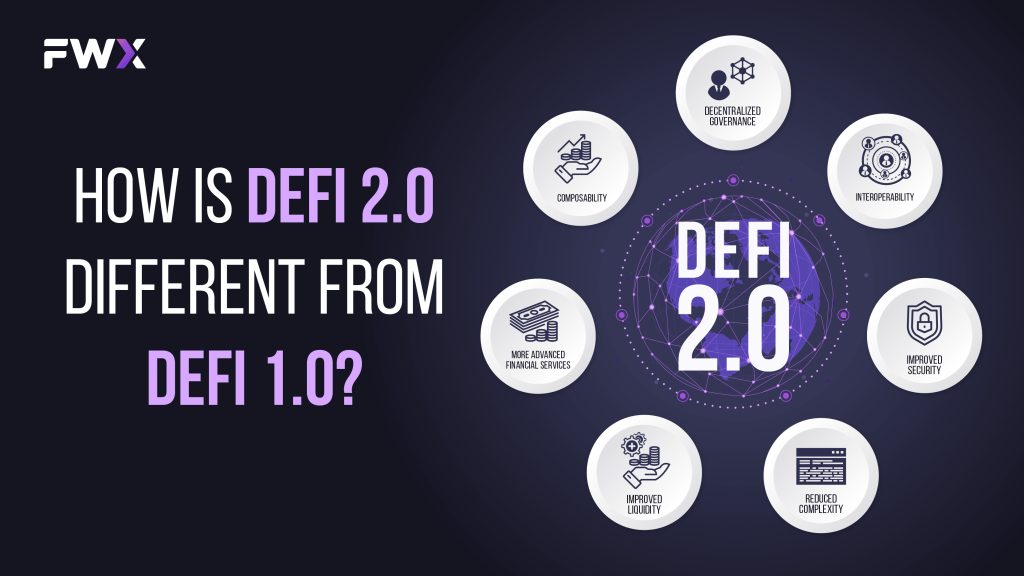
DeFi 2.0 is different from DeFi 1.0 in a number of ways, including:
- Improved security: DeFi 2.0 protocols are designed to be more secure than DeFi 1.0 protocols. They use a variety of security measures to protect users’ funds, such as multi-signature wallets and audited smart contracts.
- Reduced complexity: DeFi 2.0 protocols are designed to be easier to use than DeFi 1.0 protocols. They have more user-friendly interfaces and provide more educational resources.
- Improved liquidity: DeFi 2.0 protocols are designed to improve liquidity. They use a variety of mechanisms to attract liquidity providers, such as liquidity mining and yield farming.
- More advanced financial services: DeFi 2.0 protocols are designed to provide more advanced financial services than DeFi 1.0 protocols. They offer a wider range of financial products, such as asset management, insurance, and derivatives.
In addition to these general differences, DeFi 2.0 protocols are also focusing on a number of specific areas, such as:
- Interoperability: DeFi 2.0 protocols are being designed to be more interoperable with each other and with other blockchains. This will make it easier for users to move their assets between different DeFi protocols and blockchains.
- Decentralized governance: DeFi 2.0 protocols are increasingly being governed by decentralized autonomous organizations (DAOs). This gives users more control over the development and management of the protocols.
- Composability: DeFi 2.0 protocols are designed to be more composable, meaning that they can be easily integrated with each other to create new and innovative financial products and services.
The next generation of Decentralized Finance
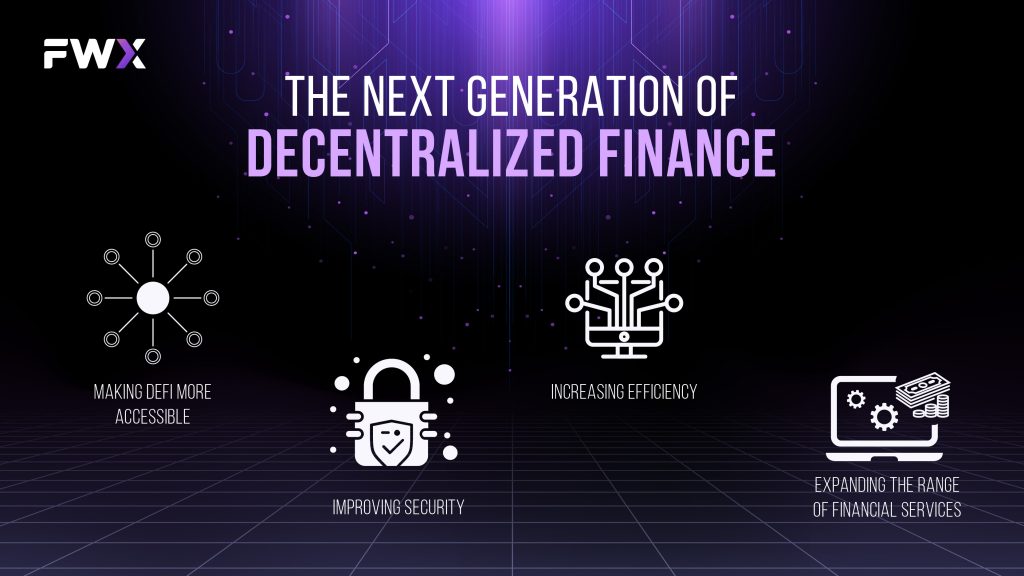
The next generation of decentralized finance (DeFi) is poised to revolutionize the financial industry. DeFi 2.0 protocols are addressing the limitations of DeFi 1.0, such as security risks, complexity, and limited liquidity. DeFi 2.0 protocols are also focusing on new areas, such as interoperability, decentralized governance, and composability.
Here are some of the ways that DeFi 2.0 is shaping the next generation of finance:
- Making DeFi more accessible: DeFi 2.0 protocols are designed to be easier to use than DeFi 1.0 protocols. They have more user-friendly interfaces and provide more educational resources. This will make DeFi more accessible to a wider range of people, including those who are not familiar with blockchain technology.
- Improving security: DeFi 2.0 protocols are designed to be more secure than DeFi 1.0 protocols. They use a variety of security measures to protect users’ funds, such as multi-signature wallets and audited smart contracts. This will help to reduce the risk of hacks and exploits.
- Increasing efficiency: DeFi 2.0 protocols are designed to be more efficient than DeFi 1.0 protocols. They use new technologies, such as Layer 2 scaling solutions, to reduce transaction fees and improve transaction speeds. This will make DeFi more attractive to users and businesses.
- Expanding the range of financial services: DeFi 2.0 protocols are offering a wider range of financial services than DeFi 1.0 protocols. This includes services such as asset management, insurance, and derivatives. This will make DeFi a more comprehensive financial solution for users.
Overall, DeFi 2.0 is making DeFi more accessible, secure, efficient, and comprehensive. This is shaping the next generation of finance, and it is likely to have a major impact on the way that people interact with financial services in the future.
Here are some specific examples of how DeFi 2.0 is being used to create new and innovative financial products and services:
- Decentralized exchanges (DEXs) are using DeFi 2.0 protocols to improve liquidity and reduce fees. For example, Uniswap V3 uses a concentrated liquidity model to improve liquidity for popular trading pairs.
- Lending and borrowing protocols are using DeFi 2.0 protocols to offer more flexible and efficient lending and borrowing products. For example, Aave V2 allows users to borrow assets at variable or fixed interest rates.
- Asset management protocols are using DeFi 2.0 protocols to offer more sophisticated asset management products. For example, Set Protocol allows users to create and invest in custom asset baskets.
- Insurance protocols are using DeFi 2.0 protocols to offer more decentralized and affordable insurance products. For example, Nexus Mutual allows users to purchase insurance against smart contract hacks and exploits.
- Derivative protocols are using DeFi 2.0 protocols to offer more innovative and complex derivative products. For example, Synthetix allows users to trade synthetic assets that track the price of real-world assets, such as stocks and commodities.
These are just a few examples of how DeFi 2.0 is being used to create new and innovative financial products and services. As DeFi 2.0 continues to develop, we can expect to see even more innovative and groundbreaking applications of this technology.


